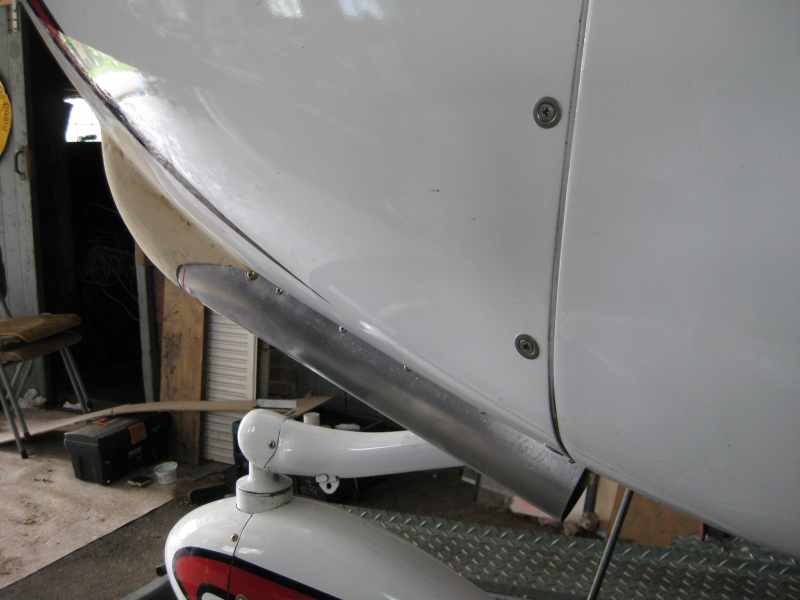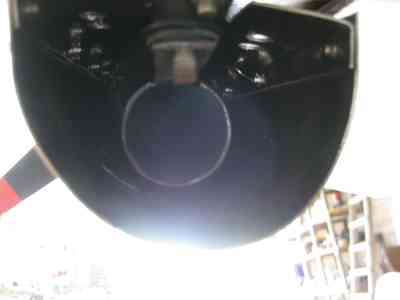frans(at)privatepilots.nl
Guest
|
 Posted: Thu Jun 10, 2010 6:39 am Post subject: exhaust augmentor Posted: Thu Jun 10, 2010 6:39 am Post subject: exhaust augmentor |
 |
|
Some people asked me for pictures about my exhaust augmentor. I think it
might be worth discussing about this on the forum, so here we go.
What is an exhaust augmentor?
An exhaust augmentor is a construction that makes use of the kinetic
energy of the exhaust flow to suck out air from the cowling. There are
of course other ways to promote air flow through the cowling, but they
come with a price, usually paid in drag. The use of exhaust energy to
suck out cowling air is free, and as an additional benefit, it also
works when the aircraft is on the ground, without airflow.
How does it work?
When the diameter of the exhaust suddenly increases, the exhaust flow
should reduce in speed to keep the same volume per time travelled. As
exhaust gas has inertia, it will try to keep the same speed, so the
larger volume has to be filled with something else. This is the same as
how a venturi works. It generates a vacuum at the other end.
All this is simply realised by hiding the exhaust inside a duct, and
then to make the exhaust somewhat shorter than the duct, so the exhaust
flow "sees" a sudden increase in diameter, and generates a vacuum in
this area. The other (front) end of the duct is connected to the space
inside the cowling. With some work one could duct it to specific places,
but I opted to keep it simple and just end it where the exhaust curves
upward to the silencer.
Why do you need an exhaust augmentor?
1) Negative drag, or propulsion. Exhaust gas contains precious energy.
The outflow of exhaust can be a propulsive force (jet engines work that
way). But you have to aim it in the proper direction, and to mix it
properly with the air flow around the airplane. Mixing hot air and cold
air will provoke turbulence; the lower the temperature of the exhaust,
the less drag is associated with it.
By mixing exhaust air with cowling air, the exhaust flow is reduced in
temperature and increased in volume at the same time. It can then be
release safely without burning the airplane, and without creating excess
turbulence. Also the aluminium duct is cooled by air flow from the
outside, providing an ever more gradual temperature difference between
inside and outside.
2) Cooling. The exhaust augmentor sucks out the air of the cowling. This
is in some setups the main cooling for ground operations. The Long-Eze
people often cool their engines with the use of an exhaust augmentor.
Most Europa's can benefit from additional ground cooling as well.
3) Elimination of exhaust drag. The exhaust is normally a round tube
poking out of the side of the cowling. Round tubes are among the worst
aerodynamic profiles, with other words, they produce a lot of drag. An
exhaust augmentor allows the exhaust to be streamlined, eliminating yet
another source of drag.
4) To exit the exhaust of the cowling, you have to make a hole in the
cowling, with enough space to allow for engine vibrations. It is unclear
in the Europa setup whether this hole allows air out of the cowling, or
lets air in, but both options are unwelcome as they hinder cooling and
produce unnecessary drag. With an exhaust augmentor, the exhaust hole is
fully functional.
5) Exhausts produce "dirt". In the original Europa setup, carbon and oil
is deposited on the leading edge of the port wing, the wheel pants of a
tri gear, the flap hinges, etc. With an exhaust augmentor, the dirt is
deposited on the underside of the plane, where it is out of sight.
6) Noise. The source of the exhaust noise is heat. Cool down the gasses
inside the exhaust, and you won't hear the noise anymore, at least no
more than the exhaust of a vacuum cleaner. Of course the exhaust
augmentor will not cool down the exhaust completely, but the reduction
in sound is probably measurable.
About the pictures.
Keep in mind that this is an experimental setup. I had to rework the
cowling anyway because of cooling modifications, so I decided that this
was the time to experiment with an exhaust augmentor. The setup is not
yet painted or anything.
The first thing you need is a new exhaust tube. A company specialized in
building stainless steel exhausts was willing to weld one on my
directions. The new exhaust was 200 grams heavier than the original one.
Then you need a duct, an enclosure. I make one of a sheet of aluminium,
bended with a 8 cm diameter, into a U-shape. The top of the U is closed
with an aluminium heat shield, allowing some space between the foot well
and the shield. Cool air is drawn through this space as well, to keep
the bottom of the foot well cool.
The exhaust should be shorter than this duct to generate the sucking
effect. I made it 5 cm shorter, but this was just guessing. The best
length can be found with experimentation, but is a bit cumbersome to do.
I noticed just a slight discolourisation at the end of the inside of the
duct, so obviously the exhaust fumes have expanded there just enough to
reach the duct. I think this means that this is about the optimum shape.
If the duct is discoloured over a longer distance, there is no vacuum
effect anymore in that area, if it doesn't touch the duct, some air
might even enter via the exit in opposite direction to fill up the void.
In front of the duct is a shape, attached to the cowling, to make a
smooth transition between the cowling and the exhaust augmentor. It is
not yet fully sanded, nor painted, but a rough representation about how
it is going to look like.
To protect the fuselage in the direct vincinity of the exhaust, I put a
small aluminium plate against the underside of the airplane, spaced
3mm's off the underside, to allow air to circulate between it. This
proves to work well.
As the Europa classic also exits the exhaust on the underside of the
airplane, I consider this as safe to do.
Test results:
1) The foot well doesn't run hot, not even with full power on the ground.
2) The aluminium duct feels hot over its entire length, despite the fact
that it is in the propeller stream and gets a lot of cooling. In my
opinion this can't be contributed to radiant heat alone, it means that
hot air from inside the cowling is rushing out via this duct.
Keep in mind that I have closed off the front 3 inch round inlets, so I
have no ram air. Instead, I have two naca ducts in the top cowling aimed
at the cylinders, but due to their location they are out of the
propeller wash. This means on the ground I have little airflow inside
the cowling. It appears that the augmenter is making up for this.
3) If I open up the coolant access door after a ground test session, it
normally feels like opening a furnace. This is no longer the case: it
feels relatively cold inside, but after a few seconds, suddenly hot air
exits the access door opening. Hot air starts to rise up. This might
indicate that as long as the engine is running, there is quite some
airflow through the cowling.
4) In flight I could not see an obvious increase in speed. This means
that if there is a speed difference, it is probably low. Unfortunately,
I have also changed the inlet of the radiator at the same time (this was
a failed attempt to get the two radiators in tandem working) and this
new setup is likely to have more drag. It could be that the augmentor is
making up for the drag penalty of the new radiator inlet. The latter I
will revert back to its original shape soon.
Frans
| | - The Matronics Europa-List Email Forum - | | | Use the List Feature Navigator to browse the many List utilities available such as the Email Subscriptions page, Archive Search & Download, 7-Day Browse, Chat, FAQ, Photoshare, and much more:
http://www.matronics.com/Navigator?Europa-List |
|
| Description: |
|
| Filesize: |
29.98 KB |
| Viewed: |
1128 Time(s) |

|
| Description: |
|
| Filesize: |
10.79 KB |
| Viewed: |
1128 Time(s) |

|
|
|




